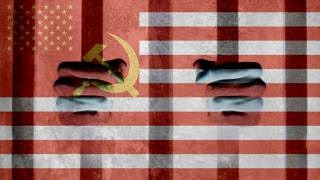What Communists did to my Family in the Soviet Gulags
A good way to grasp the breadth of communism’s evils is to understand the depth of the suffering in the lives of its individual victims.
On February 9, 1940, seven-year-old Witold Rybicki and his family awoke in the middle of the night to banging on the door of their home in Lida, Poland (modern Belarus). Outside was an officer of the Soviet secret police, then called the NKVD, who gave his father orders: “Do not run away. Your house is surrounded by soldiers. You have an hour to pack your personal belongings. Do not worry about bringing much. Everything you need will be at your destination.
This all seems long ago and far away--until you think about the anti-White hatred so apparent on the left today. Like the Soviets, I very much doubt that they would have a problem with eliminating Whites who oppose the creation of the New American people.https://t.co/Ioly9hh7N9
— Kevin MacDonald (@TOOEdit) November 9, 2017
The Rybickis were never informed of charges against them, evidence of wrongdoing, a sentence, or their destination. Witold, his parents, and four of his siblings were taken from their home to a train station, where they were loaded into a cattle car about 15 meters long by five meters wide along with about 40 other people. The car was completely bare otherwise, with just a hole in the middle of the floor for a toilet.
For nearly a month, the train traversed Eastern Europe and Russia toward Siberia, not allowing anyone outside of the cramped, filthy cars except for a short period on Saturdays. Every morning, soldiers delivered four gallons of water and one of soup for the entire car of 40 people.
The prisoners finally disembarked in a city called Tomsk. From there, they walked two days through the Siberian taiga (forest) in the dead of winter to a set of barracks with small, barren rooms built specifically for Poles. This was part of the Soviet gulag system, a chain of forced-labor camps and settlements where tens of millions of prisoners were punished and “reeducated” by the state through grueling physical labor in harsh conditions.
This account of life under Soviet rule is not an extreme outlier, but indicative of how the communist regime treated its own people. This week marks 100 years since the revolution that gave rise to communism in Russia and, subsequently, Eastern Europe, Asia, Africa, and Latin America. Avowedly Marxist regimes killed anywhere from 65 to 100 million people, a total so high that it is impossible for the human mind to conceptualize.
So goes the apocryphal Joseph Stalin quote, “One death is a tragedy; a million deaths is a statistic.” A good way to grasp the breadth of communism’s evils is to understand the depth of the suffering in the lives of its individual victims. That’s why the stories of the Rybickis and others are apropos.
The Rybickis Are Just a Few Out of Millions
The Rybickis’ plight is eerily similar to the famed accounts catalogued by Aleksandr Solzhenitsyn in “The Gulag Archipelago.” From the psychologically poignant nighttime arrest without explanation, to the inhumane transport by cattle car, to hard labor under-clothed in the bitter cold, to the starvation, to the omnipresent stench of death, to the totalizing oppression even outside of the gulags, the parallels between Witold’s story and other victims’ are striking.
The Union of Soviet Socialist Republics (USSR) and Nazi Germany invaded Poland in September 1939 and partitioned the country in two. The USSR deported to Siberia about one and a half million of the 13 to 14 million Poles in the eastern half of the country. Hundreds of thousands of them died or were executed in the process. Over decades, millions of kulaks, Cossacks, Ukrainians, Kazakhs, Soviet veterans, and Orthodox Christians, among others, suffered similar fates. The USSR killed 20 to 30 million of its own people in total.
Those who were considered educated, middle class, overtly religious, or had served in the military were the primary targets, according to Witold, because they were broadly viewed as threats to the communist regime. His father, Stanislaw, was a Polish veteran who owned a small farm, so off to the gulag system he and his family went.
A few months later, the Rybickis were moved even farther east, by train to the last city on the tracks, then by foot to another nondescript set of barracks in the middle of the Siberian taiga. It was a new labor settlement, where they would stay for three years.
In the Rybickis’ settlement, able-bodied prisoners above the age of 12 worked felling trees, preparing lumber, and collecting sap in weather that would sometimes fall to 50 below zero degrees Celsius. The laboring prisoners were given a ration of 400g of bread daily, roughly 1,200 calories, while non-working prisoners were given 200g, a measly 600 calories. Sometimes food shipments would get delayed to the camps, and prisoners like the Rybickis would go days without eating.
“We were practically starving to death,” Witold recalls. Some prisoners had “swollen, huge bellies” from hunger. Prisoners were “dying like flies all around” from hunger, disease, or being worked to death. There was a makeshift cemetery by the settlement where “hundreds and hundreds were buried.”
Read the rest here.






















